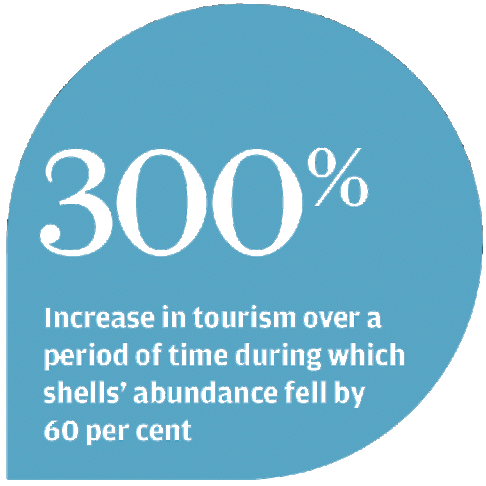
Seashells lost from beaches because of tourism, but tourists not at fault
A study found crucial shells were disappearing from a Spanish beach, but it didn't blame theft
You might think twice next time you snag a seashell from the beach and drop it into your pocket: You might be altering the seaside environment.

The study focused on a stretch of coastline on Spain's northeastern Mediterranean shore called Llarga Beach, where the researchers conducted monthly surveys of seashell abundance between 1978 and 1981.
At the time they weren't thinking of ecology: they were doing paleontology research, to understand what happens to shells after the organisms that inhabit them die.
"Only later did our research group realise that this quantitative data set offered us a unique opportunity to evaluate changes in shell abundance on a beach that was increasingly frequented by tourists," said Michal Kowalewski, a curator at the Florida Museum of Natural History in the US and the leader of the study.
The researchers returned to the same beach three decades later. They found that the abundance of seashells had decreased by 60 per cent while tourism had increased in the area by 300 per cent. Even though other factors might play a role in the shells' decline, it is hard not to think that human behaviour is to blame for the decline in seashells.
Humans seem even more culpable when you add in the seasonal pattern: shell abundance was especially low in the tourist-heavy summer months of 2008 to 2010 compared with the rest of the year. In addition, the loss of seashells can't be attributed to fisheries, since the area hasn't seen any new commercial fisheries since the 1970s, the researchers found. Nor has there been much urban development. And there haven't been any major ecological or environmental changes that might account for the decline.
But could beachgoers who pocketed seashells - or bought them at beach shops - really account for what Kowalewski found? Probably not.
"Shell collecting by beachcombers is an intuitively obvious explanation," he said, "but many other processes with tourism can lead to removal or destruction."
Grooming the sand with heavy machinery, for example, can destroy shells. Such grooming is common at tourist beaches around the world. Another way in which tourism contributes to shell decline, the study suggested, is through the use of recreational vehicles on the sand.
The decline in shell abundance in the summers of 2008, 2009 and 2010 - but not in the summers of 1978 to 1981 - provides a clue that heavy machinery may indeed bear a large proportion of the blame. "This is a peak of the tourist season," Kowalewski said, "but also the only time of the year when tractors with rakes are used regularly."
Those tractors weren't in wide use in the late 1970s, which is probably why the summer changes weren't seen then, the authors of the study suggest. So while tourism may be at fault, it's not individual tourists themselves who deserve the blame.
